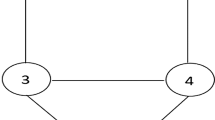Abstract
The Lorentz lattice gas is studied from the perspective of computational complexity theory. It is shown that using massive parallelism, particle trajectories can be simulated in a time that scales logarithmically in the length of the trajectory. This result characterizes the “logical depth” of the Lorentz lattice gas and allows us to compare it to other models in statistical physics.
Similar content being viewed by others
References
M. H. Ernst and G. A. van Velzen, Lattice Lorentz gas,J. Phys. A: Math. Gen. 22:4611 (1989).
M. H. Ernst and G. A. van Velzen, Long-time tails in lattice Lorentz gases,J. Stat. Phys. 57:455 (1989).
H. van Beijeren and M. H. Ernst, Diffusion in Lorentz lattice gas automata with backscattering.J. Stat. Phys. 70:793 (1993).
M. H. Ernst, J. R. Dorfman, and D. Jacobs, Mean-field theory for Lyapunov exponents and Kolmogorov-Sinai entropy in Lorentz lattice gases,Phys. Rev. Lett. 74:4416 (1995).
E. G. D. Cohen and F. Wang, Novel phenomena in Lorentz lattice gases.Physica A 219:56 (1995).
J. E. Hopcroft and J. D. Ullman,Introduction to Automata Theory, Languages, and Computation (Addison-Wesley, Reading, Massachusetts, 1979).
H. R. Lewis and C. H. Papadimitriou,Elements of the Theory of Computation (Prentice-Hall, Englewood Cliffs, New Jersey, 1981).
R. Greenlaw, H. J. Hoover, and W. L. Ruzzo,Limits to Parallel Computation: P-Completeness Theory (Oxford University Press, Oxford, 1995).
D. S. Johnson, A catalog of complexity classes, inHandbook of Theoretical Computer Science, Vol. A:Algorithms and Complexity, J. van Leeuwan ed. (M.I.T. Press/Elsevier, 1990), p. 68.
M. R. Garey and D. S. Johnson,Computers and Intractability: A Guide to the Theory of NP-Completeness (Freeman, New York, 1979).
A. Gibbons and W. Rytter,Efficient Parallel Algorithms (Cambridge University Press, Cambridge, 1988).
J. Machta and R. Greenlaw, The parallel complexity of growth models.J. Stat. Phys. 77:755 (1994).
J. Machta and R. Greenlaw, The computational complexity of generating random fractals.J. Stat. Phys. 82:1299 (1990).
H. Venkateswaran, Circuit definitions of nondeterministic complexity classes,SIAM J. Computing 21:655 (1992).
D. A. M. Barrington and N. Immerman, Time, hardware, and uniformity, inStructure in Complexity Theory: Ninth Annual Conference (1994), p. 176.
Author information
Authors and Affiliations
Rights and permissions
About this article
Cite this article
Machta, J., Moriarty, K. The computational complexity of the Lorentz lattice gas. J Stat Phys 87, 1245–1252 (1997). https://doi.org/10.1007/BF02181282
Received:
Accepted:
Issue Date:
DOI: https://doi.org/10.1007/BF02181282




